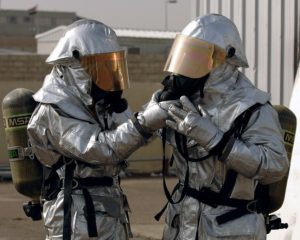Asbestos have various types like the amosite, chrysotile, tremolite, actinolite anthophyllite and crocidolite. Of these six, three are utilized more usually. Chrysotile, which is color white, is the commonest, but it is usual to encounter amosite, which is color brown or off-white, or crocidolite , which is color blue, as well.The entire kinds of asbestos tend to break into extremely tiny fibers. These single fibers are so tiny that majority must be identified by means of an asbestos microscope. In reality, certain individual fibers may be up to seven hundred times tinier than a human hair. For the reason that asbestos fibers are so minute, once emitted into the air, they may remain suspended there for hours or even days.

Asbestos fibers are also practically indestructible. They are defiant to chemicals and heat, and they are extremely stable in the surroundings. They do not vanish into air or liquefy in water, and they are not broken down over time. Asbestos is possibly the most excellent insulator known to man. For the reason that asbestos has many helpful attributes, it has been utilized in more than three thousand various products. Commonly asbestos is combined with other materials to really form the products. Floor tiles, as an example, may have a small amount of asbestos. Depending on what the product is, the quantity of asbestos in asbestos containing materials may range from one to hundred percent. Asbestos may be discovered in many various products and many various places. Examples of products that possibly have asbestos are spray on fire proofing and insulation in buildings, Ceiling tiles, floor tiles, and wall and ceiling texture in older buildings and homes. The commonest means for asbestos fibers to enter the body is by inhalation. In reality, asbestos containing material is not ordinarily considered to be dangerous unless it is releasing dust or fibers into the air where they can be breathe in or swallowed.
Numerous of the fibers will be entrapped in the mucous membranes of the nose and throat where they can then be gotten rid of, but some may pass deep into the lungs, or, if ingested into the digestive tract. Once they are trapped in the body, the fibers can cause health problems. For the reason that asbestos fibers are difficult to destroy and can only be seen under the asbestos microscope, the body cannot torn them down or remove them when they are settled in lung or body tissues. They stay in place where they can trigger disease. There are three primary illnesses linked with asbestos exposure. These are asbestosis, lung cancer and mesothelioma. Individuals who operate in asbestos mines, asbestos mills and factories, and shipyards that utilize asbestos, as well as individuals who manufacture and install asbestos insulation, have an increased risk of mesothelioma. Proof suggests that cancers in the esophagus, oral cavity, stomach, colon and kidney may be caused by ingesting asbestos.
The amount and duration of exposure – the more you are exposed to asbestos and the more fibers that enter your body, the more likely you are to develop asbestos related problems. While there is no “safe level” of asbestos exposure, people who are exposed more frequently over a long period of time are more at risk.In order to avoid being exposed to asbestos, one should be aware of the places it is likely to be found. If you have no knowledge whether something is asbestos or not, assume that it is until it is verified otherwise. Remember that one cannot tell if floor or ceiling tiles contain asbestos just by merely looking at them unless a part of it can be examined under the asbestos microscope. Never drill, hammer, cut, saw or in any way disturb any asbestos-containing materials or suspected materials.
I hope you have found this article to be very helpful with more substance than chit chat. Let me know if you would like to read similar articles in the future.
